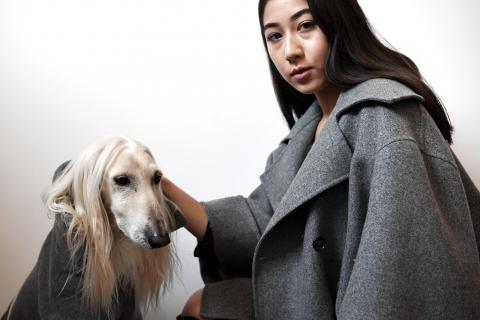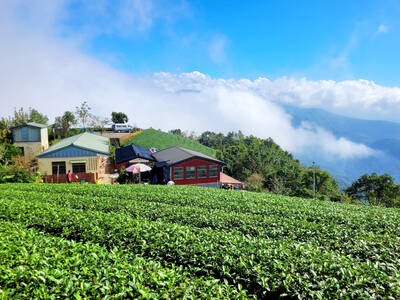Elegant, tailored outfits are not reserved just for fashionistas in Italy — couture for dogs is proving a hit with some Milan pet owners.
Man’s best friend should not be overlooked when it comes to cashmere sweaters and woolen coats, according to designer Giovanna Temellini, who enables the fashion conscious to match their style with that of their pooch.
“Everything is born out of love,” says the 57-year-old, who has been in the fashion industry for 25 years working for labels such as Bottega Veneta and Armani and is an active supporter of animal welfare groups. One evening just under a year ago in her workshop, Temellini recalled, her daughter said to her: “You do so many little things for all the dogs...” referring to her animal protection voluntary work. “But when it rains, mine gets his ears all wet,” her daughter said.

Photo: AFP
The following evening a member of her design team set to work making a hooded coat for the pet, to match the winter jacket of Temellini’s daughter.
From there sprung her made-to-measure fashion line just for dogs entitled Temellini Dog A Porter, with its first shop opening this month.
Her staff use a dog-shaped mannequin to create a range of sizes for different breeds, including dobermans, basset hounds and greyhounds.
But for each commission, the canine customer has its measurements taken to ensure a snug fit.
BECAUSE DOGS ARE WORTH IT
One dark gray jacket from her dogs’ range sports a high collar with buttons down the front, with the fabric matching a woman’s over-sized coat from Temellini’s main collection, for women, which she began 15 years ago. But the focus on high-quality fabrics and stylish cuts means a cashmere T-shirt costs 142 euros (US$171), a merino wool bomber jacket 212 euros and a coat with small pockets 252 euros.
One customer snapped up an entire wardrobe for his dog, adopted from a shelter, because after what she had been through, “she deserved it.”
Twenty-four year-old student, Beatrice Gerevini, who likes to coordinate her dog’s outfit with her own, said it helps the pair to “create a connection”.
It is also “a sort of game, a way of being noticed — people smile when they see us”. Temellini, who continues to do some work for other labels too, says she wants to create a collection suitable for all dogs, including those with disabilities. “I am very respectful and attentive to all the requirements of dogs which are to be able to move, run, get dirty and socialize.
“I refuse to do something that would restrict or ridicule a dog, because they’ll be aware of it.”

In recent weeks the Trump Administration has been demanding that Taiwan transfer half of its chip manufacturing to the US. In an interview with NewsNation, US Secretary of Commerce Howard Lutnick said that the US would need 50 percent of domestic chip production to protect Taiwan. He stated, discussing Taiwan’s chip production: “My argument to them was, well, if you have 95 percent, how am I gonna get it to protect you? You’re going to put it on a plane? You’re going to put it on a boat?” The stench of the Trump Administration’s mafia-style notions of “protection” was strong

Every now and then, it’s nice to just point somewhere on a map and head out with no plan. In Taiwan, where convenience reigns, food options are plentiful and people are generally friendly and helpful, this type of trip is that much easier to pull off. One day last November, a spur-of-the-moment day hike in the hills of Chiayi County turned into a surprisingly memorable experience that impressed on me once again how fortunate we all are to call this island home. The scenery I walked through that day — a mix of forest and farms reaching up into the clouds

With one week left until election day, the drama is high in the race for the Chinese Nationalist Party (KMT) chair. The race is still potentially wide open between the three frontrunners. The most accurate poll is done by Apollo Survey & Research Co (艾普羅民調公司), which was conducted a week and a half ago with two-thirds of the respondents party members, who are the only ones eligible to vote. For details on the candidates, check the Oct. 4 edition of this column, “A look at the KMT chair candidates” on page 12. The popular frontrunner was 56-year-old Cheng Li-wun (鄭麗文)

“Eighteen years ago, people didn’t even know the name of this ingredient,” says 58-year-old Gil Sa-hyeon, holding up a cluster of dried brownish stems. “Now it’s everywhere.” His shop, Joseon Yakcho, sits in the heart of Seoul’s Yangnyeongsi Market, South Korea’s largest traditional medicinal herb market, its streets lined with shops displaying buckets of herbs such as licorice root and cinnamon bark that spill on to the pavements, filling the air with their distinct, earthy aroma. The ingredient Gil is referring to is hovenia dulcis, known in Korean as heotgae — the oriental raisin tree that’s become the cornerstone of South Korea’s